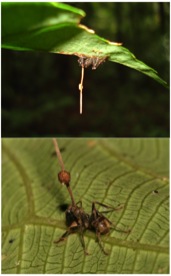By Savannah Richard
Not much attention is given to non-agricultural related insect pathogens and parasitic fungi, making these fungi all the more mysterious and fascinating. Ophiocordyceps unilateralis is a fungal pathogen that parasitizes its host; in this case Camponotus leonardi ants and other close relatives are the victims. Ophiocordyceps unilateralis is in the Ascomycota phylum and was previously in the Cordyceps family but has recently diverged into its own genus (Pontopiddan et al 2009). This fungus can be found in most tropical environments from South America, Africa to Eastern Asia.
Ants become infected when they are on the forest floor foraging and spores, laying on leaves or other dead ants, attach to the exoskeleton. These spores penetrate the ant’s exoskeleton to  eat away at the soft tissue inside. During this process of feeding off the ants tissue the fungus produces compounds that affect the ant’s brain and subsequently change the ant’s behavior. The exact cause is still unknown but the infected ants crawl up a tree and attach themselves using their mandibles to the underside of a leaf. Mycelia then grow through the bottom exoskeleton of the ant onto the leaf to help secure the ant (Anderson et al 2012). Ants have also been found to position themselves facing north almost exactly 25cm from the forest floor; in high humidity areas. These conditions are ideal for fungal growth and are attributed to the fungal pathogens control of the ant’s behavior, hence the nickname zombie fungi (Andersen et al 2009).
eat away at the soft tissue inside. During this process of feeding off the ants tissue the fungus produces compounds that affect the ant’s brain and subsequently change the ant’s behavior. The exact cause is still unknown but the infected ants crawl up a tree and attach themselves using their mandibles to the underside of a leaf. Mycelia then grow through the bottom exoskeleton of the ant onto the leaf to help secure the ant (Anderson et al 2012). Ants have also been found to position themselves facing north almost exactly 25cm from the forest floor; in high humidity areas. These conditions are ideal for fungal growth and are attributed to the fungal pathogens control of the ant’s behavior, hence the nickname zombie fungi (Andersen et al 2009).
After the ant has attached itself to the leaf and has died, the fungus begins the last part of its life cycle. A wiry stalk grows out of the ant’s head that has perithecia (spore bearing surface) at the ends, as shown in this video: http://www.youtube.com/watch?v=XuKjBIBBAL8. The fungus then drops the spores back onto the forest floor and waits for another host to pass through to infect. The entire life cycle of Ophiocordyceps unilateralis takes around 4-10 days. This fungus is also known to attack large groups of ants and almost wipe out entire colonies (Anderson et al 2009). This leaves behind several ant corpses on the underneath of leaves which scientists have coined as “ant graveyards”. Ants have adapted ways of sensing graveyards and avoiding these areas in the forest. With this developed sensitivity to Ophiocordyceps unilateralis ants have also been shown to carry out other infected ants into the forest away from the rest of the colony (Pontoppidan et al 2009).
All Cordyceps species including Ophiocordyceps species are thought to have medicinal properties. Cordyceps species produce a bio-metabolite called cordycepin, which has anti-inflammatory and anti-tumor properties. Cordyceps also contain many nutritional compounds such as B1, B2, B12, and K vitamins. In traditional Chinese medicine Cordyceps were used to aide in bronchitis, asthma, respiratory and cardiovascular diseases. Pharmaceutical companies have been able to isolate cordycepin and turn it into powder form for mass production. Culturing Cordyceps is now being experimented with to some degree of success and may expand in availability sometime in the near future (Tuli and Sandhu 2013).
References:
Andersen, S., Ferrari, M., Evans, H., Elliot, S., Boomsma, J., Hughes D., (May 2012)
Disease Dynamics in a Specialized Parasite of Ant Societies. Plos One. Retrieved from: http://www.plosone.org/article/info%3Adoi%2F10.1371%2Fjournal.pone.0036352
Andersen, S., Gerritsma, S., Yusah, K., Mayntz, D., Hywel-Jones, N., Billen, J., Boomsma, J., Hughes, D. (September 2009) The Life of a Dead Ant: The Expression of an Adaptive Extended Phenotype. The American Naturalist, Volume 174, No.3 Retrieved from http://www.jstor.org/stable/10.1086/603640
BBC Worldwide. Cordyceps: attack of the killer fungi- Planet Earth Attenborough BBC wildlife. ( November 2008) Retrieved from: http://www.youtube.com/watch?v=XuKjBIBBAL8.
Pontoppidan, M., Himaman, W., Hywel-Jones, N., Boomsma, J., Hughes, D., (March 2009) Graveyards on the Move: The Spatio-Temporal Distribution of Dead Ophiocordyceps-Infected Ants. Plos One. Retrieved from: http://www.plosone.org/
Tuli, H., Sandhu, S., (February 2006) Pharmacological and Therapeutic potential of Cordyceps, with special reference to cordycepin. 3 Biotech, volume 4, issue . Retrieved from: http://link.springer.com/article/10.1007/s13205-013-0121-9
